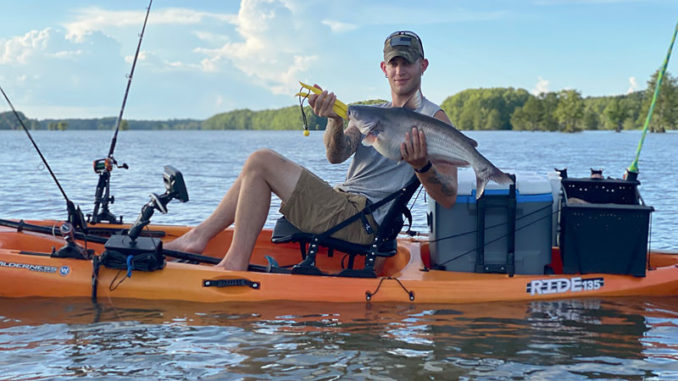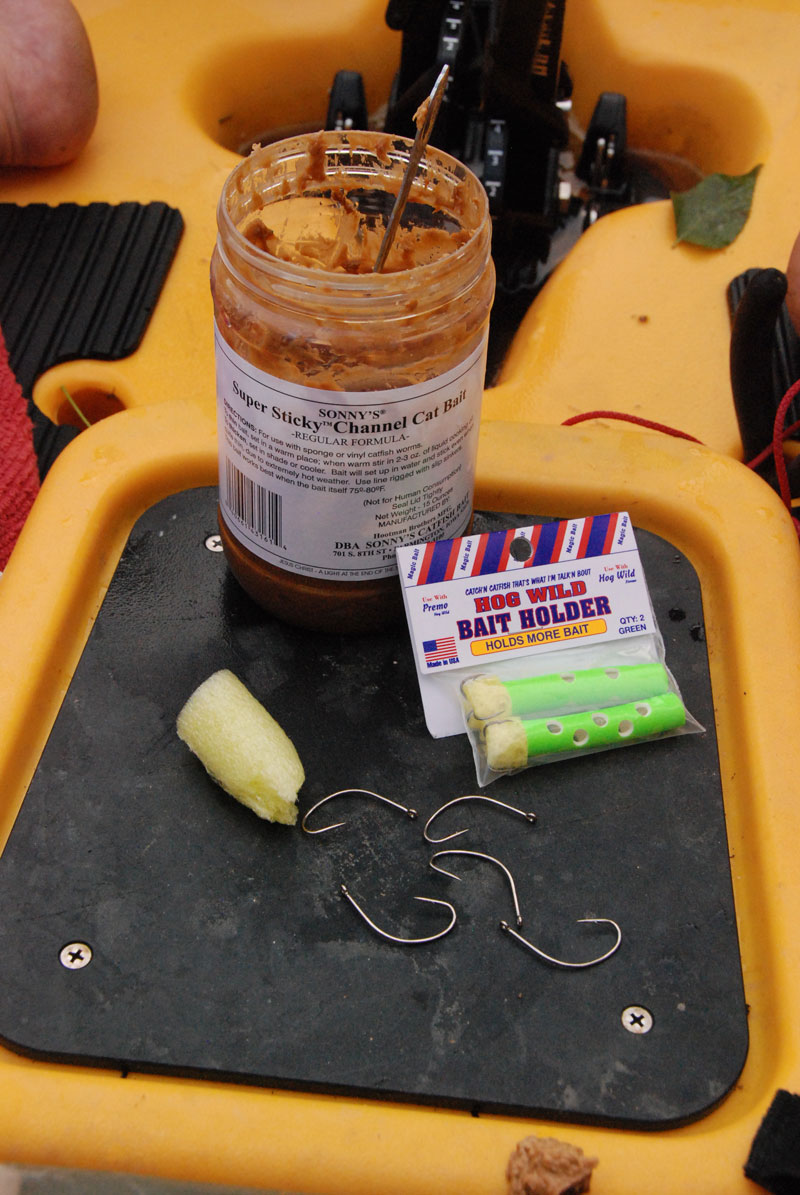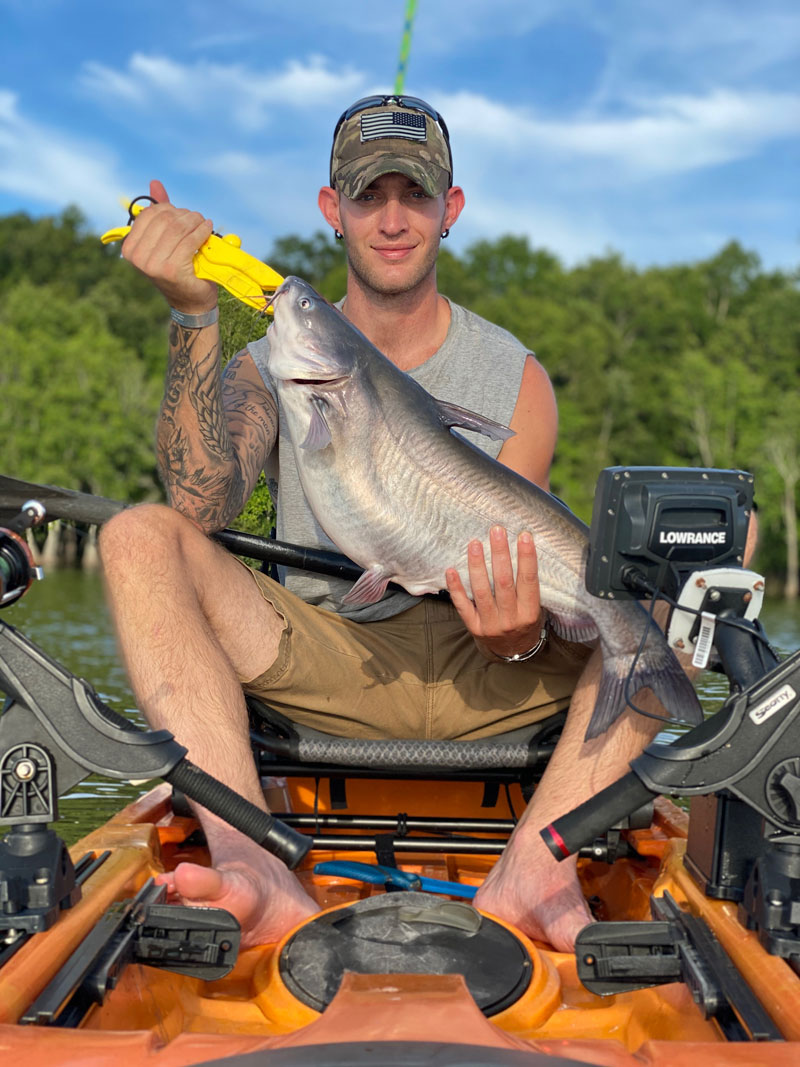
Kayaks can get to water inaccessible by larger catfish craft
Late spring is great time to invade the shallows of almost any local lake, river or pond and tangle with some tasty, eating-size catfish. May can be a tough time to latch onto a trophy blue cat during the annual spawn. But channel cats and sub-adult blues seem to be everywhere you look in water 10 feet deep or less.
An added bonus is the possibility of a flathead catfish. They tend to become more active as the weather and water warms up.
Catfishing from a kayak is no different than catfishing from any other style of boat. The ’yak angler, of course, has the ability to launch in locations inaccessible to larger craft. The tradeoff to the added access is storage space and range. Planning for storing and deploying the desired number of rods, whether only one or half a dozen, will make things easier when you locate a good fishing spot.
A number of baits will fit the bill. But some of the most popular and easiest to keep and store are commercially made catfish dip baits, sometimes referred to as stinkbaits. These are fished with sponges, pieces of pool noodle or any other permeable medium to which the bait will stick.
The best way to target channel cats and eating-sized blues with dip baits is to find an open-water area where deep water meets shallow. If the wind, waves, or current are pushing from shallow to deep, place the baits accordingly to call the cats in. The basic idea is to anchor your kayak on humps and points, in depth ranges from 5 to 20 feet.
Holding the dip
The purpose of the sponge is to hold the dip bait. If commercially made tubes or sponges aren’t your thing, you can use a thumb-size piece of pool noodle on a Carolina rig. The older the noodle, the better.
Place the piece of noodle on the hook then drop the noodle in the bait jar and spread it on with a spoon. That way, you don’t have to touch the bait and get it all over you.

Fishing for eating-sized catfish is not limited to still bodies of water like lakes, reservoirs and ponds. Fishermen report having great success with using dip baits and noodles for catfish in large creeks and smaller rivers, basically anywhere channel cats are found.
The primary difference with using this tactic in moving water is you will have to reel it in and check your bait a little bit more often because the current washes the bait off. You’ll also do better to throw the bait upcurrent from where you think the catfish are and let the scent wash down to them.
On known small-cat waters, light tackle will level the playing field for catfish up to 5 pounds, making for a great fight and good eating. Other locations may warrant sticking with bigger tackle.
From the middle of May through the month of June is considered “prime time” for using dip baits for catfish, especially during daylight hours. The later into the summer it gets, the more the bite will shift into early and late and often gets better after the sun goes down.
Best Bets
NORTH CAROLINA
WHAT — Flathead catfish
WHERE — Blewett Falls Lake
HOW — The bottom of Blewett Falls is littered with stumps and logjams. Target flathead catfish in structure near the dam or in upstream area with current. When anchored near these current areas, fan cast live bait rigs to present live shad, bream, or perch in this structure.
LAUNCH — Duke Energy Yadkin-Pee Dee River Project, 800-777-9898, www.duke-energy.com/lakes/yadkin-peedee-pigeon-river
INSIDER TIP — In the warming water, it won’t take flatheads long to find your bait. But it’s best to feel the bottom with a weighted rig and know each line is knocking on wood.
SOUTH CAROLINA
WHAT — Channel catfish
WHERE — Lake Murray, Lake Monticello
HOW — Many kayak anglers choose to drift stinkbaits or a local favorite, shrimp, on Carolina rigs or slinky weight rigs. Long clay points out to 10 to 15 feet of water are prime locations.
LAUNCH — Both lakes feature multiple public boat launch sites and several drop in sites for a kayak. https://www2.dnr.sc.gov/ManagedLands/BoatRamp/BoatRampSelected/
INSIDER TIP — While most channel catfish will be oriented to the bottom, they love to suspend up in the water column, especially when actively feeding.
The Carolinas’ big 4 catfish species

According to publications from the American Fisheries Society, 13 species of catfish reside within the Carolinas. Of these, four species are mad toms, a tiny catfish that’s more at home in a fish tank or as bait rather than quarry. Six are bullheads. These never get much angling attention, except for the white catfish. The remaining four species are the heavy hitters that garner the most recreational angler interest.
White catfish. The white catfish is one of the larger bullheads. It has a moderately forked tail, which is the best way to distinguish it from others. Its coloration is bluish-gray above with a white belly. In the Carolinas, its habitat includes many of the lower coastal-plain rivers and waterways and stretches into the upper Piedmont. They are often confused with juvenile blue cats or channels of similar ages. The tail of a white cat is not nearly as forked as a blue. And the fish lacks the spots and yellow or greenish tint of a channel.
Channel catfish. This more-slender catfish is pale blue to olive with yellow accents above it’s white belly. Dark spots and an anal fin with a rounded edge distinguish the channel, although the spots may not yet appear on young fish and fade with larger ones. The tail is also deeply forked, and it has prominently large eyes. Channels reside just about everywhere in the Carolinas, owing in part to it’s favored status in pond stockings and with commercial growers for food.
Blue catfish. The most-popular sportfish among cats in the Carolinas is the blue. It is a generally larger cat and sports a bluish-colored back that may bleach to near white in the cold. It also has a humped back at the dorsal fin. This helps to distinguish it from the channel catfish. The blue also has a deeply forked tail.
Flathead catfish. Flatheads are easily distinguished from other cats by a flat head, protruding lower jaw, small beady eyes and a rounded, not forked, tail. Their coloration goes from muddy yellow to sea monster green, with a mottled tone. They prefer dark, hidden holes around undercut banks, logjams, and big rocks. They are more active at night and during warmer weather. Flatheads were introduced in several Atlantic states. They have taken hold in the Pee Dee, Santee, Edisto, Savannah, Cape Fear and Roanoke rivers and the reservoirs on those systems. Fisheries biologists don’t hold the flathead in very high regard because they eat a lot of smaller native panfish species.





Be the first to comment